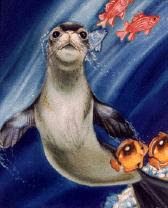Color an endangered Hawaiian Monk Seal pup:
The Hawaiian Monk Seal
Scientific name: Monachus schauinslandi
On July 6, 2000, the residents on the island of Kauai were treated to a very special event. A baby Hawaiian monk seal, or pup, was born on the shores of Poipu beach. Yellow tape was set up around the mother and pup to keep onlookers at a safe distance. Volunteers kept a watchful eye on the seals 24 hours a day, insuring that the pair was not disturbed.
Well, you might ask, why all the hoopla? After all, California sea lions gather in rookeries by the thousands. First of all, Hawaiian monk seals usually steer clear of the populated, major Hawaiian Islands. They are usually found in the French Frigate Shoals, Northwest of the Hawaiian Islands. Secondly and more importantly, Hawaiian monk seals are endangered. Today, there are less than 1,500 Hawaiian monk seals in the entire world.
 Hawaiian monk seals are one of only two mammals that are endemic, or found only in Hawaii. Adult seals weigh 400 to 600 pounds (females are generally larger) and feed on fish, squid, and crustaceans. Pups are black at birth, and grow at a rapid rate as they feed on their mother's rich milk. Mother doesn't eat the entire time that is spent nursing her pup...that means no meals for six weeks! By this time, poor hungry mom has lost almost a third of her of her weight, and the chubby pup has put on more than a hundred pounds! Imagine if your baby brother or sister weighed 150 pounds when he or she was only six weeks old.
Hawaiian monk seals are one of only two mammals that are endemic, or found only in Hawaii. Adult seals weigh 400 to 600 pounds (females are generally larger) and feed on fish, squid, and crustaceans. Pups are black at birth, and grow at a rapid rate as they feed on their mother's rich milk. Mother doesn't eat the entire time that is spent nursing her pup...that means no meals for six weeks! By this time, poor hungry mom has lost almost a third of her of her weight, and the chubby pup has put on more than a hundred pounds! Imagine if your baby brother or sister weighed 150 pounds when he or she was only six weeks old.
"Winged Feet"
Hawaiian monk seals are pinnipeds (PIN-uh-pedz). Pinniped means "winged feet", and with their flippers and sleek bodies, these mammals are well-adapted to life at sea.
Seal or Sea Lion?
True seals have no external ears, and their hind flippers can't turn forwards. Seals, like the monk seal, harp seal, and harbor seal, are very awkward on land. They drag themselves about with floppy, undulating motions. But once these blubbery pinnipeds enter the water, look out! Their torpedo-shaped bodies cut through the water with ease, and they can dive to tremendous depths. The Antarctic Weddell seal can dive to 2,000 feet and stay underwater for up to 73 minutes!
Sea lions and fur seals belong to the Sea Lion family. These pinnipeds have external ears, and they can turn their hind flippers forwards, making it easier for them to move on land. The California sea lion is the most popular of all, and is commonly seen in marine shows and circuses.
Hawaiian name: ilio-holo-i-ka-uaua, quadruped that runs in the rough seas.
Recommended reading for children:
The Hawaiian Monk Seal, by Patrick Ching. University of Hawaii Press, Honolulu, 1994.
The Story of Hina, by Patrick Ching. Island Heritage, 1999.
Sources: Macmillan Illustrated Animal Encyclopedia, Dr. Philip Whitfield, Ed. Macmillan Publishing Company, New York, 1984.
NOAA Monk Seal Recovery Plan
With Senator Dan Inouye at NOAA's Recovery Plan Ceremony. Painting by Tammy Yee.
In the past few years, the Hawaiian monk seal population has plummeted to 1,200 individuals, making it the United States' most endangered marine mammal. The oldest living seal species, it is one of only two remaining tropical seals--the Mediterranean monk seal is also critically endangered. A third tropical seal, the Carribean monk seal, has been extinct since the 1950s.
NOAA's recovery plan, revised after intensive research, will focus on a captive care program to nutritionally supplement vulnerable juvenile female seals.
You can help the Hawaiian monk seal by:
- Keeping distance from Hawaiian monk seals. Seals and pups are sometimes seen on popular beaches on the Main Hawaiian Islands--human interaction can disturb the mother-pup relationship and introduce disease.
- Cutting loops from six-pack holders and other plastic items before throwing them away. Marine animals can swallow them or become entangled in the plastic holes, which may lead to death.
- Disposing of unwanted fishing lines, nets and other garbage. Don't bury trash in the sand, as it will eventually be uncovered.
- Educating yourself and others about the Hawaiian monk seal:
NOAA Monk Seal Recovery Plan
Star Bulletin: Saving Monk Seals




























